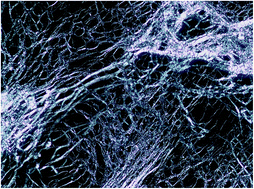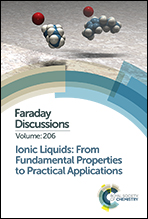How ionic species structure influences phase structure and transitions from protic ionic liquids to liquid crystals to crystals
Abstract
The phase behaviour of n-alkylammonium (C6 to C16) nitrates and formates has been characterised using synchrotron small angle and wide angle X-ray scattering (SAXS/WAXS), differential scanning calorimetry (DSC), cross polarised optical microscopy (CPOM) and Fourier transform infrared spectroscopy (FTIR). The protic salts may exist as crystalline, liquid crystalline or ionic liquid materials depending on the alkyl chain length and temperature. n-Alkylammonium nitrates with n ≥ 6 form thermotropic liquid crystalline (LC) lamellar phases, whereas n ≥ 8 was required for the formate series to form this LC phase. The protic ionic liquid phase showed an intermediate length scale nanostructure resulting from the segregation of the polar and nonpolar components of the ionic liquid. This segregation was enhanced for longer n-alkyl chains, with a corresponding increase in the correlation length scale. The crystalline and liquid crystalline phases were both lamellar. Phase transition temperatures, lamellar d-spacings, and liquid correlation lengths for the n-alkylammonium nitrates and formates were compared with those for n-alkylammonium chlorides and n-alkylamines. Plateau regions in the liquid crystalline to liquid phase transition temperatures as a function of n for the n-alkylammonium nitrates and formates are consistent with hydrogen-bonding and cation–anion interactions between the ionic species dominating alkyl chain–chain van der Waals interactions, with the exception of the mid chained hexyl- and heptylammonium formates. The d-spacings of the lamellar phases for both the n-alkylammonium nitrates and formates were consistent with an increase in chain–chain layer interdigitation within the bilayer-based lamellae with increasing alkyl chain length, and they were comparable to the n-alkylammonium chlorides.

- This article is part of the themed collection: Ionic liquids: from fundamental properties to practical applications


 Please wait while we load your content...
Please wait while we load your content...